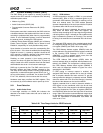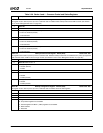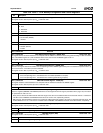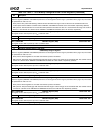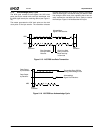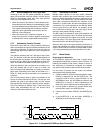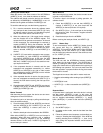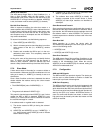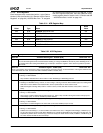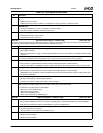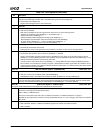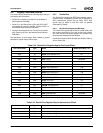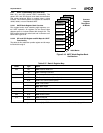
124 AMD Geode™ SC1200/SC1201 Processor Data Book
SuperI/O Module
32579B
Sending the Address Byte
When the device is the active master of the ACCESS.bus
(ACBST[1] is set), it can send the address on the bus.
The address sent should not be the device’s own address,
as defined by ACBADDR[6:0] if ACBADDR[7] is set, nor
should it be the global call address if ACBST[3] is set.
To send the address byte, use the following sequence:
1) For a receive transaction where the software wants
only one byte of data, it should set ACBCTL1[4]. If only
an address needs to be sent or if the device requires
stall for some other reason, set ACBCTL1[7].
2) Write the address byte (7-bit target device address)
and the direction bit to the ACBSDA register. This
causes the ACB to generate a transaction. At the end
of this transaction, the acknowledge bit received is
copied to ACBST[4]. During the transaction, the ABD
and ABC lines are continuously checked for conflict
with other devices. If a conflict is detected, the trans-
action is aborted, ACBST[5] is set and ACBST[1] is
cleared.
3) If ACBCTL1[7] is set and the transaction was success-
fully completed (i.e., both ACBST[5] and ACBST[4]
are cleared), ACBST[3] is set. In this case, the ACB
stalls any further ACCESS.bus operations (i.e., holds
ABC low). If ACBCTL1[2] is set, it also sends an inter-
rupt request to the host.
4) If the requested direction is transmit and the start
transaction was completed successfully (i.e., neither
ACBST[5] nor ACBST[4] is set, and no other master
has accessed the device), ACBST[6] is set to indicate
that the ACB awaits attention.
5) If the requested direction is receive, the start transac-
tion was completed successfully and ACBCTL1[7] is
cleared, the ACB starts receiving the first byte auto-
matically.
6) Check that both ACBST[5] and ACBST[4] are cleared.
If ACBCTL1[2] is set, an interrupt is generated when
ACBST[5] or ACBST[4] is set.
Master Transmit
After becoming the bus master, the device can start trans-
mitting data on the ACCESS.bus.
To transmit a byte in an interrupt or polling controlled oper-
ation, the software should:
1) Check that both ACBST[5] and ACBST[4] are cleared,
and that ACBST[6] is set. If ACBCTL1[7] is set, also
check that ACBST[3] is cleared (and clear it if
required).
2) Write the data byte to be transmitted to the ACBSDA.
When either ACBST[5] or ACBST[4] is set, an interrupt is
generated. When the slave responds with a negative
acknowledge, ACBST[4] Register is set and ACBST[6]
remains cleared. In this case, if ACBCTL1[2] Register is
set, an interrupt is issued.
Master Receive
After becoming the bus master, the device can start receiv-
ing data on the ACCESS.bus.
To receive a byte in an interrupt or polling operation, the
software should:
1) Check that ACBST[6] is set and that ACBST[5] is
cleared. If ACBCTL1[7] is set, also check that the
ACBST[3] is cleared (and clear it if required).
2) Set ACBCTL1[4] to 1, if the next byte is the last byte
that should be read. This causes a negative acknowl-
edge to be sent.
3) Read the data byte from the ACBSDA.
Before receiving the last byte of data, set ACBCTL1[4].
5.7.7.1 Master Stop
To end a transaction, set the ACBCTL1[1] before clearing
the current stall flag (i.e., ACBST[6], ACBST[4], or
ACBST[3]). This causes the ACB to send a Stop Condition
immediately, and to clear ACBCTL1[1]. A Stop Condition
may be issued only when the device is the active bus mas-
ter (i.e., ACBST[1] is set).
Master Bus Stall
The ACB can stall the ACCESS.bus between transfers
while waiting for the host response. The ACCESS.bus is
stalled by holding the AB1C signal low after the acknowl-
edge cycle. Note that this is interpreted as the beginning of
the following bus operation. The user must make sure that
the next operation is prepared before the flag that causes
the bus stall is cleared.
The flags that can cause a bus stall in master mode are:
• Negative acknowledge after sending a byte (ACBST[4]
= 1).
• ACBST[6] bit is set.
• ACBCTL1[7] = 1, after a successful start (ACBST[3] =
1).
Repeated Start
A repeated start is performed when the device is already
the bus master (ACBST[1] is set). In this case, the
ACCESS.bus is stalled and the ACB awaits host handling
due to: negative acknowledge (ACBST[4] = 1), empty
buffer (ACBST[6] = 1) and/or a stall after start (ACBST[3]
1).
For a repeated start:
1) Set \ACBCTL1[0] to 1.
2) In master receive mode, read the last data item from
ACBSDA.
3) Follow the address send sequence, as described pre-
viously in "Sending the Address Byte". If the ACB was
awaiting handling due to ACBST[3] = 1, clear it only
after writing the requested address and direction to
ACBSDA.



